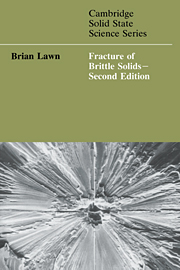Book contents
- Frontmatter
- Contents
- Preface
- Glossary of symbols and abbreviations
- 1 The Griffith concept
- 2 Continuum aspects of crack propagation I: linear elastic crack-tip field
- 3 Continuum aspects of crack propagation II: nonlinear crack-tip field
- 4 Unstable crack propagation: dynamic fracture
- 5 Chemical processes in crack propagation: kinetic fracture
- 6 Atomic aspects of fracture
- 7 Microstructure and toughness
- 8 Indentation fracture
- 9 Crack initiation: flaws
- 10 Strength and reliability
- References and reading list
- Index
1 - The Griffith concept
Published online by Cambridge University Press: 14 January 2010
- Frontmatter
- Contents
- Preface
- Glossary of symbols and abbreviations
- 1 The Griffith concept
- 2 Continuum aspects of crack propagation I: linear elastic crack-tip field
- 3 Continuum aspects of crack propagation II: nonlinear crack-tip field
- 4 Unstable crack propagation: dynamic fracture
- 5 Chemical processes in crack propagation: kinetic fracture
- 6 Atomic aspects of fracture
- 7 Microstructure and toughness
- 8 Indentation fracture
- 9 Crack initiation: flaws
- 10 Strength and reliability
- References and reading list
- Index
Summary
Most materials show a tendency to fracture when stressed beyond some critical level. This fact was appreciated well enough by nineteenth century structural engineers, and to them it must have seemed reasonable to suppose strength to be a material property. After all, it had long been established that the stress response of materials within the elastic limit could be specified completely in terms of characteristic elastic constants. Thus arose the premise of a ‘critical applied stress’, and this provided the basis of the first theories of fracture. The idea of a well-defined stress limit was (and remains) particularly attractive in engineering design; one simply had to ensure that the maximum stress level in a given structural component did not exceed this limit.
However, as knowledge from structural failures accumulated, the universal validity of the critical applied stress thesis became more suspect. The fracture strength of a given material was not, in general, highly reproducible, in the more brittle materials fluctuating by as much as an order of magnitude. Changes in test conditions, e.g. temperature, chemical environment, load rate, etc., resulted in further, systematic variations in strengths. Moreover, different material types appeared to fracture in radically different ways: for instance, glasses behaved elastically up to the critical point, there to fail suddenly under the action of a tensile stress component, while many metallic solids deformed extensively by plastic flow prior to rupture under shear.
- Type
- Chapter
- Information
- Fracture of Brittle Solids , pp. 1 - 15Publisher: Cambridge University PressPrint publication year: 1993
- 1
- Cited by



